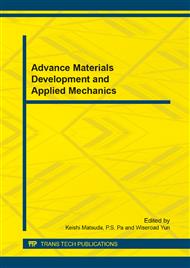[1]
GB 11551-2003, The protection of the occupants in the event of a frontal collision for passenger car[S](in Chinese).
Google Scholar
[2]
GB 15083-2006, Strength requirement and test of automobile seats, their anchorages and any head restraints[S](in Chinese).
Google Scholar
[3]
GB 11550-2009, Strength requirement and test of automobile seats head restraints[S](in Chinese).
Google Scholar
[4]
KIng A I. Suggestion for making rapid advances in automotive safety in China[J]. Journal of Automotive Safety and Energy, 2010, 1(1): 1-5.
Google Scholar
[5]
Zhan Zhang-song, Xiong Shu-sheng. Study on occupant dynamics computer simulation in automotive collision[J]. Journal of Zhejiang University(Engineering Science), 2002, 1: 019.
Google Scholar
[6]
Vadiraj B, Omkar S N, Kandagal S B, et al. Human Response Characteristics to Impact Conditions During Spacecraft Takeoff and Impact Landing[J]. International Journal of Aerospace Innovations, 2012, 4(3): 95-102.
DOI: 10.1260/1757-2258.4.3-4.95
Google Scholar
[7]
Himmetoglu S, Acar M, Bouazza-Marouf K, et al. A multi-body human model for rear-impact simulation[J]. Proceedings of the Institution of Mechanical Engineers, Part D: Journal of Automobile Engineering, 2009, 223(5): 623-638.
DOI: 10.1243/09544070jauto985
Google Scholar
[8]
Himmetoglu S, Acar M, Bouazza-Marouf K, et al. Car seat design to improve rear-impact protection[J]. Proceedings of the Institution of Mechanical Engineers, Part D: Journal of Automobile Engineering, 2011, 225(4): 441-459.
DOI: 10.1177/2041299110393188
Google Scholar
[9]
Iwamoto M, Kisanuki Y, Watanabe I, et al. Development of a finite element model of the total human model for safety (THUMS) and application to injury reconstruction[C]/Proceedings of the International IRCOBI Conference. (2002).
Google Scholar
[10]
T.L. Teng, T.M. Shih, C.C. Wu, A finite element model for a frontal impact dummy, Journal of Technology 19 (1) (2004) 31–38.
Google Scholar
[11]
Nagasaka K, Mizuno K, Tanaka E, et al. Finite element analysis of knee injury risks in car-to-pedestrian impacts[J]. Traffic injury prevention, 2003, 4(4): 345-354.
DOI: 10.1080/714040492
Google Scholar
[12]
Ippili R K, Davies P, Bajaj A K, et al. Nonlinear multi-body dynamic modeling of seat–occupant system with polyurethane seat and H-point prediction[J]. International Journal of Industrial Ergonomics, 2008, 38(5): 368-383.
DOI: 10.1016/j.ergon.2007.08.014
Google Scholar
[13]
Kim S K, White S W, Bajaj A K, et al. Simplified models of the vibration of mannequins in car seats[J]. Journal of sound and vibration, 2003, 264(1): 49-90.
DOI: 10.1016/s0022-460x(02)01164-1
Google Scholar
[14]
Zhang Yan, Wang Shu-xin, Lai Xin-min, Zhu Ping. Dynamic Responses of Human Body with Belt Constraints During Vehicle Crash[J]. Mechanical Science and Technology, 2004, 23(8): 944-946(in Chinese).
Google Scholar
[15]
Yeh I, YAN F U, Kachnowski B, et al. Optimization of a vehicle restraint system using a genetic algorithm[J]. SAE transactions, 2005, 114(6): 1504-1511.
Google Scholar
[16]
S. Nishiyama, Development of simulation system on vehicle-occupant dynamic interaction (1st Report, Theoretical analysis and system verification), Transactions of the Japan Society of Mechanical Engineers C 59(568) (1993) 3613–3621.
DOI: 10.1299/kikaic.59.3613
Google Scholar
[17]
S. Nishiyama, Development of simulation system on vehicle-occupant dynamic interaction (2nd Report, Influenceof sitting posture on human comfort), Transactions of the Japan Society of Mechanical Engineers C 59 (568)(1993) 3622–3629.
DOI: 10.1299/kikaic.59.3622
Google Scholar
[18]
S. Nishiyama, Development of simulation system on vehicle-occupant dynamic interaction (3rd Report, Influence of parameters of occupant-seat system on human comfort), Transactions of the Japan Society of Mechanical Engineers C 60 (573) (1994).
DOI: 10.1299/kikaic.60.1509
Google Scholar


